|
|
|
|||
|
|
||||
|
|
||||
| Smoke Trails | ||||
|
|
HOME | SITE MAP | FORUM | CONTACT |
|
||
|
ABOUT | MOTORS | MODELS | ARCHIVE | HISTORY | STORE | FAQ | LINKS
|
|
|
|
|
|
||||||||||||||||||||||||||||||||||||||||||||||||||||||||||||||||||||||||||||||||||||||||||||||||||||||||||||
|
Smoke Trails 3
(April 2006)
by Roger Simmonds Reprinted from SAM 35 Speaks, April 2006 Flying Saucery The discussion of Bill Dean’s Space Scooter and Skycraft’s Flying Saucer in the first Smoke Trails engendered some welcome correspondence. First, here is a vintage photo (right) of Brian Knott with his brother, about which Brian comments, “As lads we didn’t have much pocket money, so we used to drill out wooden cotton reels to hold a Jetex 50, attach balsa wings and fly them round the pole indoors with all the windows open […] I’m the lad holding a Keil Kraft Hawker Hunter in one hand, and a ‘Gort Space Ship’, manufacturer unknown, in the other. My younger brother holds a rubber powered model.” John Miller Crawford, who passed on Brian’s photo, wrote, “I’ve had it in storage awaiting a suitable occasion to use it. Perhaps this is it – is the Gort worthy of a Smoke Trail?” … Certainly! John Park also wrote concerning flying saucers: “February’s Smoke Trails reminded me of the first Jetex model I ever succeeded in flying […] I wonder if anyone can tell me what it might have been? It had a built up tissue covered wing and a thick sheet fuselage with the Jetex 50 mounted on top, right at the nose, well ahead of the CG. It was extremely simple to build, which was just as well, as I was just eight years old at the time (1954). Its flight pattern, of tight consecutive loops, whilst not exactly graceful, was highly entertaining to watch”. |
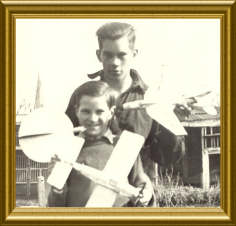 The Knott brothers with Gort, 1951
- Brian Knott (using a box camera)
|
||||||||||||||||||||||||||||||||||||||||||||||||||||||||||||||||||||||||||||||||||||||||||||||||||||||||||||
|
|
|
|||||
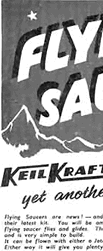
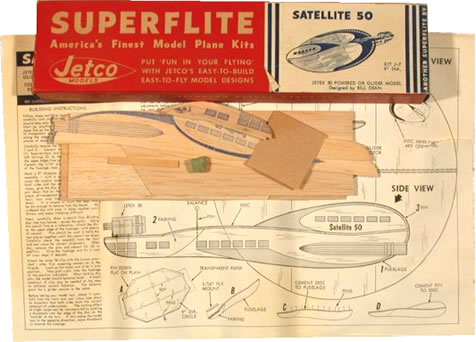
- skyboss (eBay vendor), 2006
|
|
 This 1951 advertisement identifies Brian’s model as a Keil Kraft Flying Saucer. This later mutated into the Gort Space Ship (left), as a (probably unofficial) tie-in to the film The Day the Earth Stood Still. Gort, readers will remember, was the robot. John’s description, except for the built-up wing, also fits this (‘yet another fascinating’) model brought to us by Keil Kraft.
- Model Aircraft, Feb. 1951
|
||||
|
I wonder if Bill Dean had anything to do with Gort et al, as he was associated with Keil Kraft in the early fifties, and certainly knew all about the flying qualities of these sorts of designs – the illustration on the right comes from his ‘Model Talk’, RAF Flying Review, May 1954. Dean writes: “The largest in a long, long line of disc-shaped whatsits is powered by a Jetex 350 and, being dustbin-lid size, is capable of creating a lasting impression on those unsuspecting bystanders who suddenly see it hissing towards them out of the gathering dusk!” Hmm … at last the ‘Roswell incident’ is explained! I must thank John Miller Crawford for tracking down these various saucer references. Last word on the Space Scooter should go to John Park, whose saucerer’s apprenticeship led to a love (now happily revived) of rocket-propelled models. John writes: “It was I who sent you the details of Bill Dean’s Space Scooter [thank you John, I am ashamed to say I had forgotten this and didn’t acknowledge you] which is from the Eagle Annual No 4 (1954). I’ve made a one-and-one-third scale version with the lower fuselage cut away to take a Rapier L-1 mounted just forward of the CG. All I now need is a fresh consignment of motors to see how it goes … I anticipate tight consecutive loops!” |
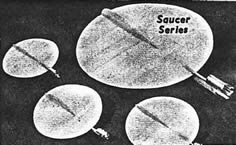 Bill Dean’s flock of flying saucers
- RAF Flying Review, June 1954
|
|||||
Bill Dean’s ‘pocket sized’ Flying Saucer (right and below) is also well worth resurrecting – the twin fins may be more compatible with the hotter and dirtier Rapier exhaust – and it should go well with anything from an L-1 upwards.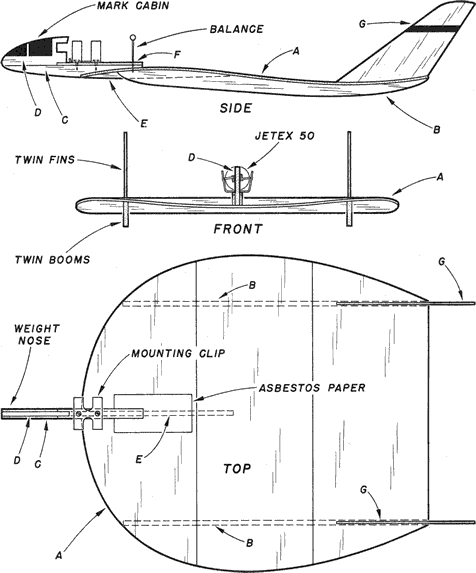 |
 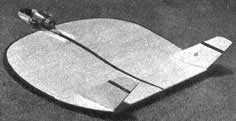
- RAF Flying Review, May 1954
Bill Dean’s [not quite a] Flying Saucer was based, he says, on the plans and sketches of the |
|||||
|
In contrast to all too many contributors to non-specialised magazines at that time, Dean understood very well that his articles would be read by novices, and his instructions were always simple and comprehensive. In this instance, not only was there a plan (above) and an assembly diagram, there were also tracings of all components, with the grade of wood for each carefully specified. The directions for trimming were equally punctilious; if followed, Dean writes, “the typical flight pattern is wide sweeping circles, often with a couple of spectacular loops near the end of the power run when thrust reaches its maximum”. Perhaps this flight pattern might also have been a consequence of a motor well in front of the CG? Ray Malmström’s Flying Saucer (right), which appeared a nearly a decade later (Eagle Annual, 1961) is also a fine testimony to the pedagogic merits of these unorthodox fun models, and Malmström’s instructions and diagrams, were, like Dean’s, exemplary. Unfortunately, as a boy, I wasn’t into ‘fun’ and so never built one. Is it too late now? |
 Ray Malmström’s Flying Saucer
- Eagle Book of Space Models, 1962 (p. 22)
|
|||||
|
More French fighters Both the French models shown right were new to me, and appear by courtesy of Pierre Claudy, who unearthed them in a special ‘Jets’ issue of Modèle Magazine, June 1955. [Follow these links to download plans from Jetex.org: Super Mystère – Aquilon] Modèle Magazine’s editorial began, "The jet pilot is the superman of our age […] we’d like to give youngsters the opportunity to gain a foothold in the world of jets by making true jet powered models, which fly just like their full-size counterparts. By doing this, we hope we can arouse in today's readers a desire to join the ranks of the supermen of tomorrow”. All good stirring stuff! Like last month’s Vampire, the Aquilon (a Sea Venom made by Sud-Est under licence from De Havilland), is for Jetex 100, which appears to have been a particular favourite of the French aviateur. The design is a nice contrast to the Keil Kraft and Skyleada Venoms – I particularly like the absence of tip tanks – and I trust the original building and trimming instructions (which I have not seen) were suitably arousing. The Super Mystère, from the same issue of MM, is by a different hand. What a pity the designer’s gaucherie results in a Jetex 50 hanging in the breeze, quite spoiling the elegant lines of the fully sheeted fuselage. Another F.D.2 |
 Super Mystère for Jetex 500  Aquilon for Jetex 100
- Modèle Magazine, 1955 (cover below)
 |
|||||
Andy Blackwell and I attended a ‘Grand Do’ at the Fleet Air Arm Museum celebrating the 1956 record-breaking flight of the Fairey Delta 2. Peter Twiss and Neville Duke were there for the presentations, and the SMAE demonstrated some wonderful models, including a couple of modern jets, though the turbine powered Javelin was, alas, only on static display. Andy and I put together a video of Rapier powered models and a booklet for our display, Aeromodelling the F.D.2 in 1956 and Steve Bage put together a new plan for a Rapier powered F.D.2: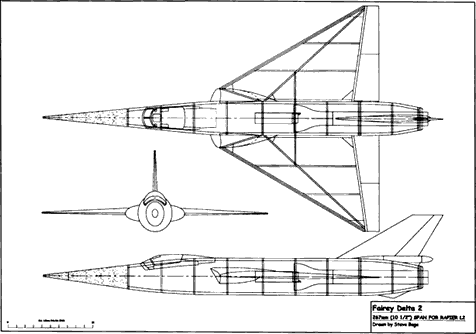 |
Simmonds’ and Blackwell’s commemorative booklet |
|||||
|
We were gratified to find some visitors that had played with Jetex in their youth, and a couple had even made a ‘Tailored’ F.D.2 (right), which, due either to penury or pusillanimity, they launched by bungee on its maiden (and only) flight with interesting results. There is one F.D.2 reminiscence, from John Park, that deserves a wide readership: “I knew something pretty special was going on before the news of the 1,132 mph record came out. I was out flying one morning in 1956 when I was astonished to see a single thin vapour trail high in the sky to the South, made by an aircraft moving at least twice as fast as I’d ever seen an aircraft move, at its head. I was still wondering about it a couple of weeks later when the news broke and all was explained. Peter Twiss’s autobiography talks of making dozens of flights close to Mach 2 before the record was set, and I’d obviously seen one of them from my home in West Surrey. Incidentally, I actually made one of those cardboard F.D.2s you could get from the Eagle. I assembled with ‘Lepage’s Liquid Glue’, as I reckoned balsa cement would distort it, and it looked pretty good; but it weighed a ton and I never tried to fly it.” There are copies of our gloriously coloured booklet (from which the above is taken) left over, so if you would like one (£10.00 inc. p&p within UK, £12.50 elsewhere) please let me know. The cardboard F.D.2 is also still available (£6.00 within UK, £8.50 elsewhere). We envisage that Steve Bage’s F.D.2 will be available in several versions, from a traditional ‘built up’ model to a fully moulded ‘Tailored’ replica. |
 Jetex publicity photo of the Fairey F.D.2
- Mike Ingram archive
|
|||||
|
|
||||||
|
|
|
|||||
|
|
|
|
|
|
|
|
Acknowledgements - Article: Roger Simmonds - Illustrations: Roger Simmonds, Steve Bage, Roger Chapman, Pierre Claudy, Mike Ingram, Brian Knott, MAAC archives via Bill Henderson |
|
|
|
|
ABOUT | MOTORS | MODELS | ARCHIVE | HISTORY | STORE | FAQ | LINKS |
|
|
Terms of Use
|
Queries? Corrections? Additions?
Please
contact us.
|
|